Top 5 Exercises for Rheumatoid Arthritis Relief Recommended by Physiotherapists
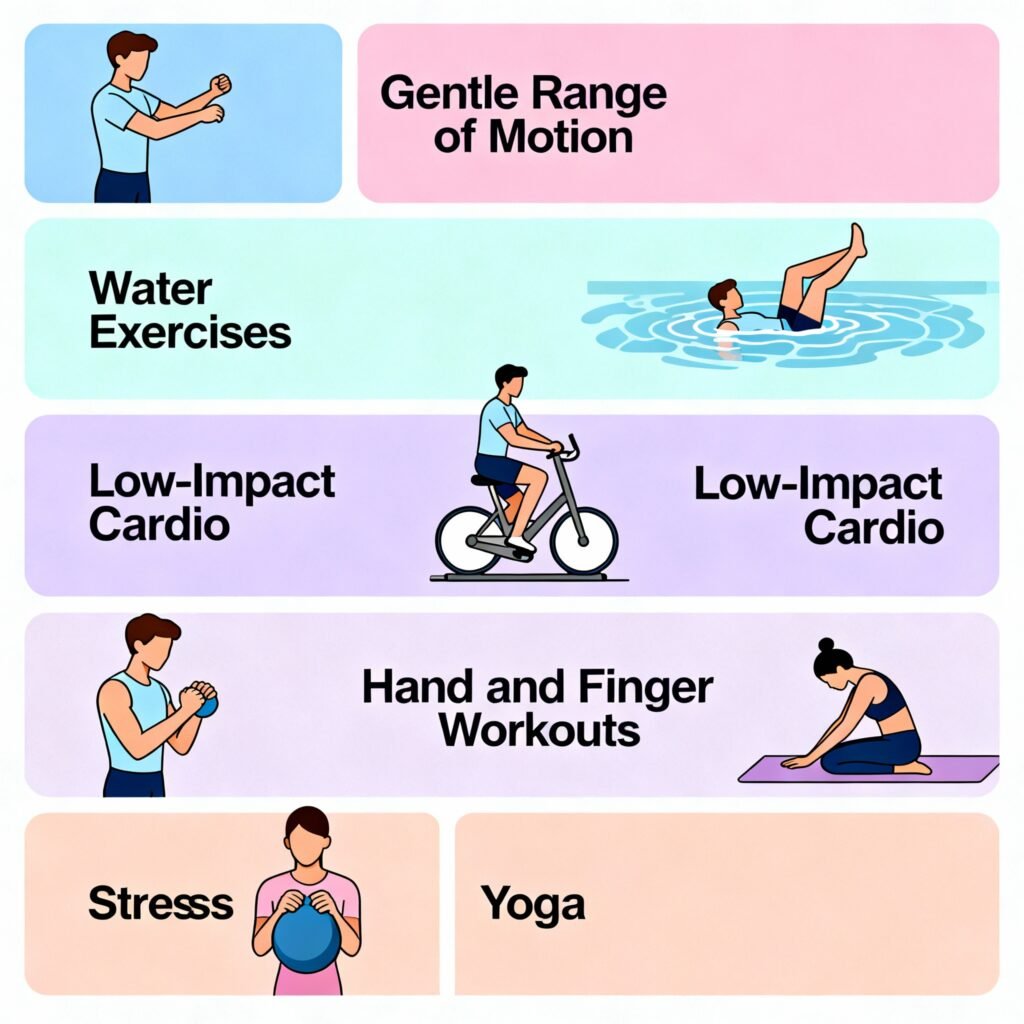
The life of a patient with rheumatoid arthritis (RA) isn’t an easy task, and every step, stretch or move can seem like a struggle. The joints get stiffer and painful, and even simple activities may require extra effort. However, there’s a bright side: movement, if performed correctly, could help to improve your condition. The physiotherapists frequently say that “Motion is lotion for your joints,” and they’re right. Certain exercises will help decrease stiffness, increase the flexibility of your joints, and restore the confidence you have in your body’s ability to move freely. We’ll look at the five most popular exercises suggested by physical therapists that will make a difference in alleviating Rheumatoid Arthritis pain as well as improving the health of joints. 1. Gentle Range of Motion (ROM) Exercises – Keep the Stiffness Away In the event that you get up at dawn and find that your joints feel stiff or stiff, gentle exercises to increase the range of motion can help relax them. The exercises help keep the joints flexible and prevent them from “freezing up.”Do this exercise: Rotate your wrists gradually, move your fingers straight and bent as you move your shoulders in circles, or slowly move your head from in a lateral direction.Physiotherapist’s suggestion: Do these movements gradually and do not force a move that you are not able to. The goal is to maintain flexibility, never pushing yourself beyond your limit. 2. Water Exercises – Let the Pool Take the Pressure Off If your traditional exercise routines or walking cause pain, water may be your most reliable companion. Exercise in warm water helps support your body’s weight, and also takes away the strain on joints, allowing you to be more comfortable and move freely.Try these: Water walking, easy leg kicks, or gentle arm movements within waist-deep waters.Why it works: The buoyancy of the water helps support joints, while the soft resistance will help you strengthen your muscles. It is soothing, safe and extremely effective in RA discomfort relief. 3. Low-Impact Cardio – Move Without Hurting Actively pursuing your goals keeps your energy levels high and your heart healthy. However, high-impact sports like jumping, jogging, or running aren’t recommended for people suffering from RA. Exercises that reduce the impact on your body can be a good option.Try these options: Brisk walking, stationary cycling, or an exercise elliptical.Tip from physical therapists: Start with small steps. A little bit of time every day can make a big change. Increase your time and be aware of your body. If you feel something is hurting, take it easy. 4. Hand and Finger Workouts – Strengthen Your Grip Rheumatoid arthritis often affects the joints in the smaller part of the hands, which makes daily tasks like buttoning up a shirt or securing a drink hard. Easy hand exercises are a great way to maintain flexibility and power.Try these: Squeeze a soft ball with your hands gently, spread your fingers, then place each fingertip on your thumb, one at a time.Physiotherapist’s note: Don’t rush it — just a few moments every day will maintain your fingers’ nimbleness and health. 5. Yoga and Mindful Movement – Relax, Stretch, and Heal Yoga is more than just exercise; it’s a therapy for your mind and body. It allows you to move with ease and stretch joints, and relax your nerves.Try these postures: Cat-Cow, Child’s Pose and Bridge Pose, which are all easy and relaxing.Why physiotherapists adore the practice. It not only enhances flexibility but also decreases stress hormones, which can cause more severe inflammation. Final Thoughts Rheumatoid arthritis is working in conjunction with the body rather than in opposition to it. The idea of exercising can seem daunting initially, but after you begin moving, your body will begin to appreciate it. Each little step is important -even during the worst days. Don’t forget that it’s not necessary to do it all on your own. A certified professional in physiotherapy in Gurgaon will help you through safe, customised exercise routines that match your life and your comfort level. With the correct assistance, you’ll be able to perform your exercises with less discomfort and greater confidence throughout the day. Frequently Asked Questions (FAQs) Does exercise actually help in reducing the pain of rheumatoid arthritis?Yes Absolutely. Exercise regularly, with a gentle touch, will reduce stiffness, strengthen muscles and decrease joint pain as time passes. What kinds of exercise do I need to avoid?Avoid the most jerky, high-impact activities like jumping or running, since they create too much stress on joints. Are swimming exercises beneficial for the rheumatoid joint?Definitely! Water and swimming are among the safest and most efficient workouts for individuals suffering from RA. What can I do when I experience an injury during training?Stop immediately and relax. It’s your body’s way of telling you that you’ve done enough. Resume your exercise only after the pain decreases. What can a physiotherapist do to assist me with joint pain?A physical therapist will create a personalised strategy, train you in proper technique and track your progress, ensuring that each move is beneficial and does not cause harm.
Sports Injury Recovery: Why Early Physiotherapy Matters
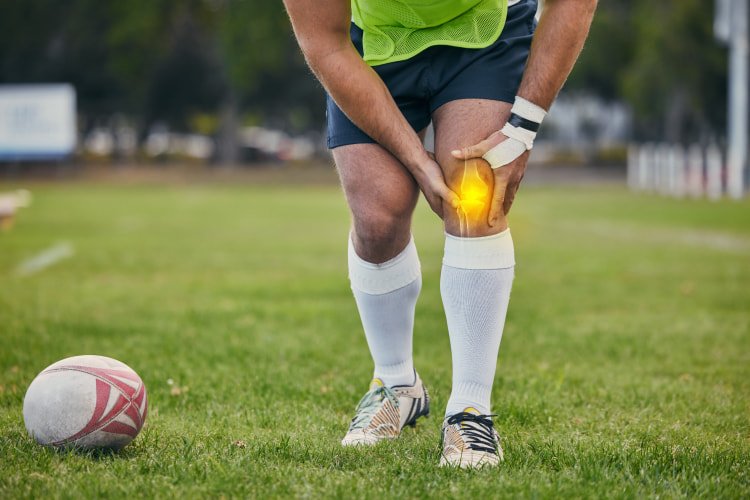
Injuries are the norm for athletes. Whether you are playing casually during the weekend or play professionally, a strain, twist, sprain, or strain could throw your entire routine off track. The recovery process from injury does not mean just taking a break and hoping that it will heal. The time of your physiotherapy sessions will make all the difference. It is important to start early so that you can recover faster, prevent chronic problems and get back to what you enjoy. What Happens When You Get Injured? If you get injured during sport, it’s generally your ligaments, muscles, joints, or tendons which are impacted. Though some injuries appear to be minor, neglecting treatment could lead to the development of complications such as arthritis, chronic pain or more severe injuries later. A few of the most commonly reported sports injuries are: Why Early Physiotherapy Is a Game-Changer The earlier you get started with physical therapy, the better. The sooner you start treatment, the less inflammation, ease pain, as well as prevent muscles and joints from gaining stiffness. If you wait too long, it could make your recovery more difficult and longer, while beginning quickly can put you on the quickest path to getting back into shape. Benefits of Acting Early: Personalised Care Matters There are no two injuries that are exactly the same. A physiotherapist evaluates the condition and creates a program which is appropriate for the body as well as your sport. The plan could involve the stretching of muscles, strength training, as well as balance exercises, manual therapy, and even hydrotherapy. Through this process, you’ll also discover how to protect yourself from injuries that could occur in the future. This is an essential aspect of staying healthy in the long run. If you live in the Gurgaon region, seeing a physiotherapist at Gurgaon will ensure that your healing is supervised by specialists who are knowledgeable about sports injuries. A prompt intervention will not only help to heal quickly but also allow you to return to play in a safe and efficient manner. FAQs When should I begin physiotherapy following the injury? Within 1-3 days for injuries that are minor, or immediately for more severe injuries. Early treatment prevents problems. Do physiotherapy and physiotherapy work in conjunction with surgical procedures?Sometimes the answer is yes. Mobility and strength exercises may help reduce the need for surgical intervention in some injuries. Does physiotherapy cause pain?It might feel a bit discomfort at times; however, treatments are adapted to suit your needs while helping to heal. How long does the recovery take?It is dependent on the type of injuries. A minor strain can heal in some weeks; however, severe injuries may last for a long time. Am I able to resume the sport immediately after receiving physical therapy?No. The physiotherapist will help you make a gradual return to your body, making sure the body is prepared to prevent re-injury.
How Stress and Poor Posture Contribute to Cervical Spine Degeneration
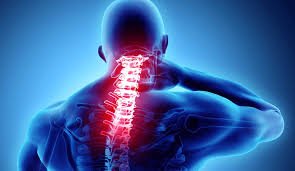
Your neck is an incredible component that is a vital part of you. It holds your head in place, it helps turn and tilt, as well as safeguards the vital nerves connecting your brain with the other parts of the body. However, many of us do not realise that we have put the neck region that is constantly under constant stress. Two of the most common causes? The most significant culprits are stress and bad posture. Stress: More Than Just a Mental Burden Everyone is aware that stress can affect the way we feel; however, it can also affect our bodies, particularly the neck. When you’re stressed out, the muscles will naturally tighten, specifically around the shoulder and neck. In constant tension, it can push the cervical vertebrae from proper alignment, cause discs to strain, and even irritate nerves. In time, the damage that this strain causes can cause pain, stiffness, as well as headaches. Because stress can make us slump or hunch our shoulders across our screens or jaws to clench and jaws, it can add tension to an already stressed neck. Poor Posture: The Silent Spine Saboteur The way you sit may not seem like an issue; however, it could have a significant impact on the health of your neck. Take a look at how many hours you are gazing at your phone or laptop each day. The forward head position, also known as “tech neck,” shifts your head’s weight to the side, placing 5-6 times more stress on your neck as compared to if your head were perfectly set. Standing or sitting in this way for a long time reduces the strength of the muscles supporting your neck. They also strain discs, which could result in bone spurs or nerve irritation. In time, this gradual injury can transform mild discomfort into constant pain. When Stress and Posture Work Together The effects of stress and posture problems frequently go hand-in-hand. When you feel stressed, it causes you to lean forward or slump, as slouching causes tension in your muscles and causes discomfort. The cycle speeds up the process of degeneration within the cervical spine. It makes the cervical spine more prone to stiffness, pain and a decrease in mobility. What You Can Do What’s good? You have a lot that you can take to help slow cervical spinal degeneration. Simple adjustments like adjusting your posture, taking a break to avoid screens, or performing easy neck exercises can aid. Techniques for managing stress, such as meditation, deep breathing or even light yoga, can help ease neck tension. Intensifying your upper neck and back muscles is another important step. If you’re experiencing pain If you’re experiencing discomfort, an expert approach is recommended. A Physiotherapist in Gurgaon can help you through a series of exercises that are customised for your needs to correct posture, as well as methods to relieve stress on the cervical spine and increase the overall health of your body. FAQs Does stress actually cause damage to your neck?Yes. Stress over time tightens the neck muscles and may cause spine disalignment. This speeds up damage and wear. How can I tell whether my posture is causing harm to the neck?Signs are a forward tilt of the head and rounded shoulders. You may also notice neck stiffness, headaches or even tingling sensations in your arms. Are there exercises I can do that can help me protect my cervical spinal column?Yes! Soft stretches, shoulder blade squeezes and strengthening of the upper back aid in maintaining neck health. Can stress reduction help my neck pain?Definitely. Relaxation techniques help reduce tension in muscles and ease tension on the cervical spine. What is the best time to see a professional physiotherapist?If neck pain continues, restricts movements, or triggers discomfort in your hands or arms, then it’s time to see a professional physiotherapist.
Boosting Immune Health Naturally While Managing Rheumatoid Arthritis
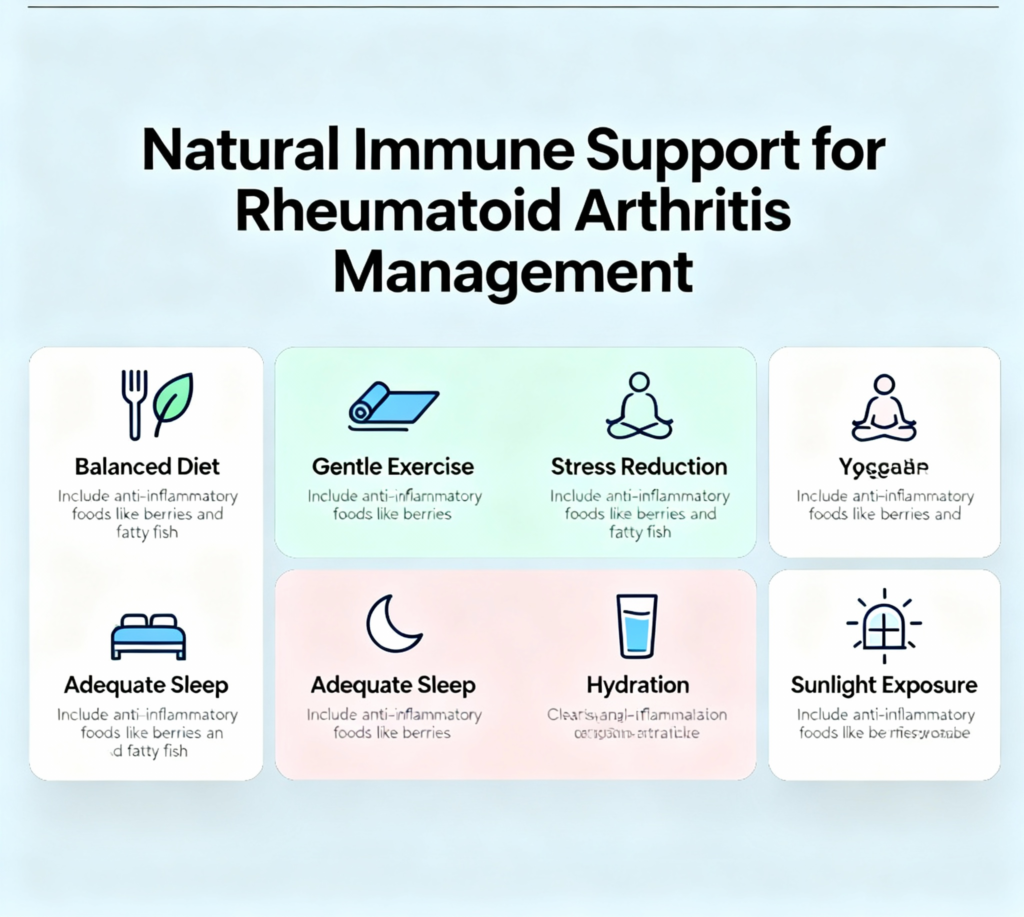
The life of a person with Rheumatoid arthritis (RA) is sometimes like an ongoing balancing act. There’s joint pain, fatigue and inflammation, all as you try to ensure your body is healthy and your immunity at bay. RA is an autoimmune disease, and the body’s defence mechanism misguides itself and attacks the joints. This is why an immune balance is extremely crucial. Although medications can help reduce flare-ups and inflammation, small changes in lifestyle, as well as natural practices, can help in helping the body recover and remain robust. 1. Eat for Healing: Select foods to fight inflammation The food you consume can have an enormous influence on your mood. Diets that are rich in color fruits, vegetables with a leaf as well as whole grains and healthy fats, provide your body with the energy it requires. The foods you eat, like garlic, turmeric and ginger, salmon, flaxseeds and walnuts, possess the natural properties of anti-inflammatories that help alleviate swelling and stiffness.Try following the Mediterranean diet -Think of olive oil, lentils, beans, fresh vegetables, and even fish. While you’re at it, you should cut back on sweet snacks, processed food, as well as red meat because they trigger inflammation and delay the healing process. 2. Keep Moving — Gentle Exercise for Joint Relief Even if you’re stiff, a gentle move can change your life. Activities like swimming, yoga and walking or even light stretching can help keep joints and muscles in good shape. Exercise also boosts the flow of blood and increases your mood. This, in turn, helps the immunity.A physiotherapist will assist you in finding suitable exercises for your fitness and condition. Regular exercise not only eases discomfort, but it also makes you feel more active and comfortable in your daily activities. 3. Calm Your Mind — Stress Less, Heal More Stress and RA are not a good match. If you’re stressed out, the body produces hormones that cause inflammation, which can cause symptoms to worsen. Find ways to relaxfor example, through yoga, meditation, or even just taking a walk, is a great way to help you make a difference.Also, take note of the benefits of a good night’s sleep. Make sure you sleep for at least seven nights of uninterrupted sleep. The body repairs itself, recharges itself, and builds your immunity while you sleep. 4. Stay Hydrated and Naturally Detoxify The water in your joints keeps them in good condition and assists in flushing out any toxins which be accumulated as a result of chronic inflammation. Drink 8-10 glasses of water a day. Herbal teas that contain ginger, turmeric or green tea are excellent healthy detox alternatives too. They reduce inflammation and boost general well-being. 5. Healthy Habits for a Stronger Immune System Every day choices can make a difference. Stop smoking cigarettes if you are able to restrict alcohol and make sure you are getting enough sunshine to get vitamin D. The small changes you make could boost energy and immunity levels. It is also possible to consider taking supplements for vitamin D, vitamin C, and zinc — however, always consult your physician before making any decisions. The right lifestyle choices can help boost your immune system and make it more stable, and make arthritis-related symptoms less difficult to control. The treatment of rheumatoid arthritis isn’t solely about managing painit’s about establishing the right lifestyle to help your body recover naturally. Combining medical treatments with healthy, natural lifestyles will help you get more control over your overall health. If you’re seeking an expert guide and customised exercises to improve joints and general wellness, seeking out a professional physiotherapist in Gurgaon could be the perfect step towards an active and pain-free life. FAQs Can eating a healthy diet help with rheumatoid arthritis?Yes. An anti-inflammatory, nutritious diet helps reduce stiffness, pain and fatigue as well as boost the immune system. What kind of workout is most suitable for RA?Low-impact, gentle exercises such as swimming, yoga and walking can help improve mobility and flexibility without stressing joints. What are the effects of stress on the rheumatoid joint?Stress causes inflammation throughout the body. It can trigger inflammation or a worsening of joint pain. Are herbal remedies safe when combined with RA medicine?Some do, but make sure to check with your physiotherapist or doctor before taking supplements or other herbs to your treatment. Does better sleep boost your immunity, RA?Absolutely. Sleeping in a deep, peaceful sleep helps your body to heal itself, decreases inflammation and boosts the immune system.
Top Exercises to Improve Flexibility and Strength for Cervical Spondylosis

Cervical Spondylosis, also known as the wear and tear of ageing necks it is more frequent than you may believe. It could cause head pain, neck stiffness and even numbness, tingling, or pain in the arms if untreated. But the bright side? By doing the correct exercises, you’ll be able to reduce discomfort, increase your flexibility and build the muscles that support your neck. Below is a list of some of the more efficient exercises that you can do from the comfort of your own home. 1. Chin Tucks – Align Your Neck Chin tucks work well for fixing posture and easing tension. How do you get it: This workout strengthens your deep neck muscles and can help ensure that your spine is properly aligned, and reduce persistent stiffness. 2. Shoulder Blade Squeeze – Strengthen Your Upper Back An upright upper back helps support the neck and stops slouching. What is it: Regularly doing this can help ease tension and improve posture with time. 3. Side Neck Stretch – Gentle Flexibility Boost This stretch is targeted at the sides of your neck and helps improve your lateral mobility. What is it: Be patient and do not force your stretch. Gentle movements are the key. 4. Isometric Neck Exercises – Build Strength Safely The exercises for neck strengthening strengthen muscles, but without excessive movements. What to do: It helps to maintain your neck’s stability and keeps tension low. 5. Shoulder Rolls – Release Tension Simple, but effective method to ease the muscles that are tight within your neck and shoulders. How do you get it: It’s an easy way to relax when you’ve spent a long time at an office or even on the phone. Get Professional Guidance While these workouts can be done safely for a majority of individuals but doing them properly is essential. A physiotherapist in Gurgaon can develop an individual program, make sure you have that you are in a good posture, and guide you through exercises to relieve the pain and avoid further neck injuries. FAQs Are exercises able to cure cervical spondylosis?Exercises don’t cure the condition. However, they do help reduce pain, increase mobility, and stop it from getting worse. What is the best time to work out the neck?Daily moderate exercises lasting between 15 and 20 minutes are ideal to keep your neck strong and flexible. What activities should I steer clear of?Avoid fast jerky movements, heavy lifting or exercises that are high impact in the absence of supervision. Can yoga help treat neck spondylosis?Yes! Yoga poses that are gentle, such as cat-cow and neck stretches, aid in physiotherapy and help improve flexibility. Do I need to visit a professional physiotherapist?If there is constant pain, numbness, and weakness or even dizziness, seek out a physiotherapist immediately.
Understanding Carpal Tunnel & Wrist Pain: Prevention and Treatment
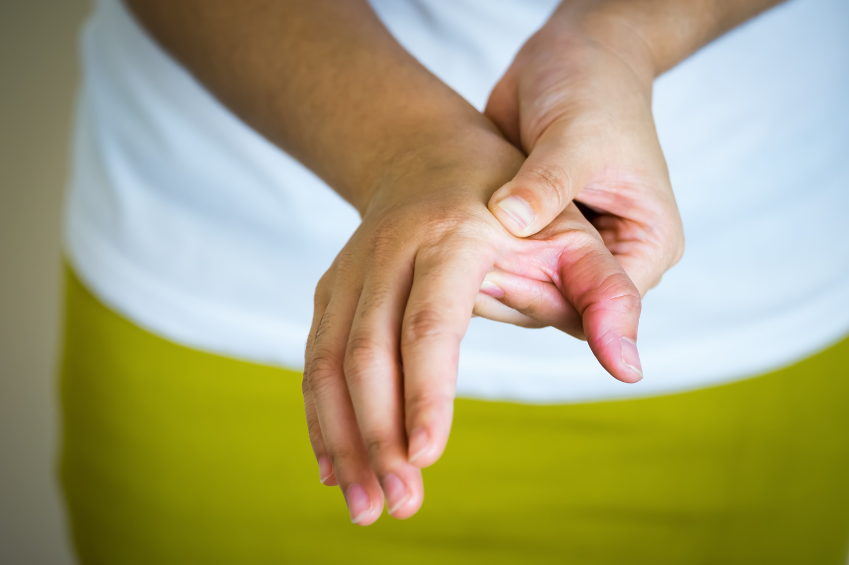
In our modern, fast-paced and tech-driven daily life, wrist pain is getting more common. The long hours spent typing, playing with a mouse, or regular hand movements may cause wrist pain and eventually, cause irritation or the condition known as carpal tunnel syndrome (CTS). Finding out what triggers it, as well as how to identify the symptoms and methods to treat it, will assist in protecting your wrists and hands. What is Carpal Tunnel Syndrome? Carpal Tunnel Syndrome occurs when the median nerve that connects the forearm towards your hand is squeezed at your wrist. This nerve plays a role in sensation and movement throughout the various parts of your hands. If pressure is built up, the nerve can cause the sensation of numbness or tingling. The sensation of pain. Common Signs of CTS What Causes Wrist Pain and CTS? Many factors may be the cause of carpal tunnel syndrome, as well as general wrist pain. How to Prevent Carpal Tunnel Syndrome It is possible to reduce the risk of developing wrist pain by making just a couple of simple changes to your lifestyle: Treatment Options for Wrist Pain Treatment is based on the severity of your symptoms. The Role of Physiotherapy It is usually the most effective method of managing wrist pain, and also prevents CTS from getting worse. A physiotherapist is able to: If you are experiencing wrist pain, you should consult with a professional physiotherapist in Gurgaon, who will help you develop specific treatment plans for quick relief and longer-term wrist well-being. FAQs Do you think carpal tunnel syndrome will disappear by itself? Mild symptoms may ameliorate with time and good posture; however, persisting CTS will require professional treatment. How long will physiotherapy be required to treat CTS?If you follow a consistent treatment plan, the majority of patients see improvement within about 6-8 weeks. Should wrist braces assist?Yes, particularly at night, they help keep your wrist in a neutral position and lessen pressure on nerves. Are exercises able to make CTS more severe?Incorrect exercises may cause worse symptoms. Therefore, the advice of a physiotherapist is essential. Does surgery have to be done every time in the case of CTS?It isn’t, it’s only thought of when conventional treatments do not work.
Dealing with Osteoarthritis: How Physiotherapy Slows Progression & Eases Pain
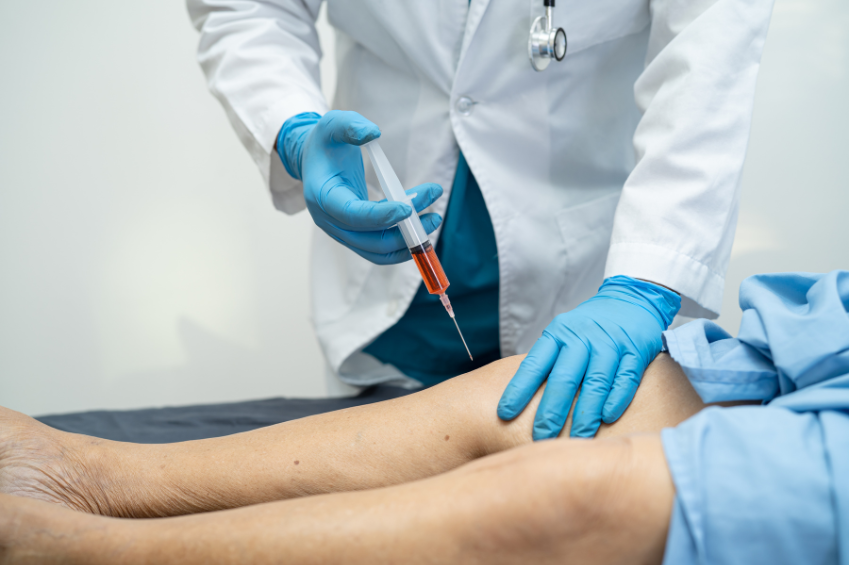
Osteoarthritis (OA) is an issue that many suffer from when they get older. It occurs when the cartilage, which cushions joints, begins to wear down and causes stiffness, pain and a reduced range of motion. There isn’t an immediate cure for OA, but physiotherapy could help in slowing down the development of OA as well as helping patients keep healthy and at ease. Understanding Osteoarthritis Osteoarthritis typically affects the hand, knees, hips and the spinal column. It is a slow-growing condition, and its symptoms can often be overlooked initially. Signs that are common include: Being able to detect OA earlier is vital. The earlier it’s dealt with, the more likely you are of reducing arthritis and ensuring joints are in good health. How Physiotherapy Can Help The physiotherapy method is non-invasive to treat osteoarthritis and enhance the quality of your lifestyle. A physiotherapist will design an individual program that addresses: Reduce Pain and Inflammation Therapists employ techniques such as heat and cold treatment, ultrasound and electrical stimulation to alleviate joint pain as well as reduce inflammation. This allows you to get more comfortable moving. Strengthen Muscles Around the Joints The stronger muscles can support joints that are weak, decreasing strain and speeding up wear on cartilage. A physiotherapist will design workouts that are specifically tailored to your needs. Improve Flexibility and Mobility Exercises that stretch and increase the range of motion can aid in loosening stiff joints, which makes movement more fluid and less difficult. Improve Balance and Posture Osteoarthritis could affect your ability to sit and move. The physiotherapy program focuses on balance and position to help make daily tasks safer and less uncomfortable. Learn Joint Protection Techniques Physical therapists show you how to safely move, employ aids and devices to support you, as well as perform exercises to help protect joints and avoid further damage. Lifestyle Matters The best results from physiotherapy are when it is combined with simple habits of life. A healthy weight, exercising regularly, as well as taking a balanced and healthy diet, affects the health of joints. If you’re dealing with Osteoarthritis and need individualised care, seeking out a physiotherapist in Gurgaon can assist you in reducing pain, increasing mobility, and stopping the progression of your condition. FAQs What is the best time to practice physical therapy?Typically, 3 sessions a week are recommended for the first time and accompanied by a personal exercise schedule for daily assistance. Are there exercises I can do at home with OA?Your physiotherapist is able to help you do secure and efficient home workouts. Do physiotherapy exercises pose a risk to elderly adults suffering from OA?Absolutely. The exercises are tailored to each person, which makes them suitable and safe for all ages. What is the earliest time I will see improvements?Many patients notice fewer symptoms and greater mobility in the first 4-6 weeks of regular exercise.
What to Do When Your Hip or Knee Starts to Hurt: Early Signs & When to See a Physio
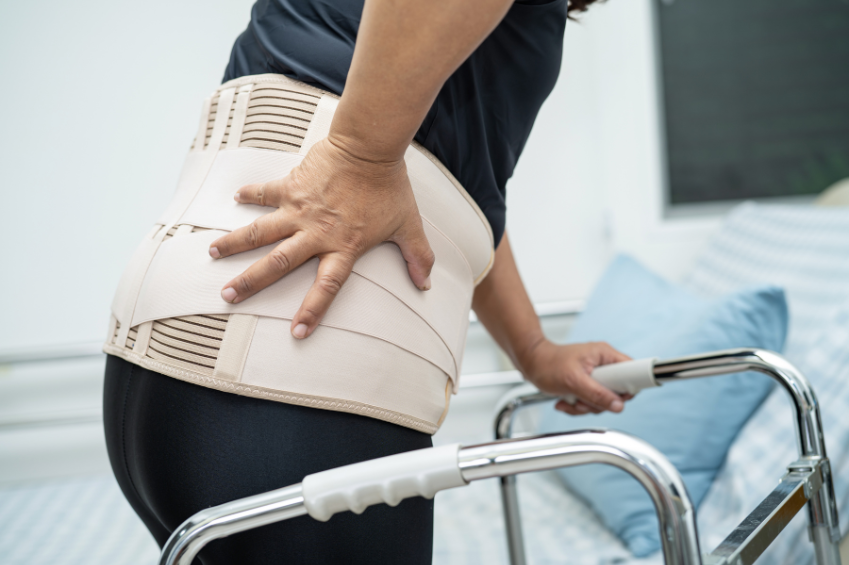
Knee and hip pain is a problem that many have experienced at least once. There can be a persistent discomfort after an extended day or even a painful ache upon stepping up the stairs or stepping out of bed. Although occasional discomfort is common, chronic or serious pain should not be overlooked. Being aware of the signs early and acting quickly can protect the patient from future issues and help you move more comfortably. Early Signs to Watch Out For Being aware of the initial alert signs could help a lot: Common Reasons Your Hips or Knees Hurt The cause of pain can be a variety of causes: Quick Steps to Ease Discomfort If you need professional assistance, however, there are some urgent steps at home.e When to See a Physiotherapist If your pain doesn’t ease after the next few days, or becomes more intense, or is affecting the way you live, you should consult a physical therapist. The physiotherapist can: If you’re suffering from Knee or Hip Pain, getting in touch with a physiotherapist in Gurgaon will help you return to motion in a safe and efficient manner. FAQs 1. What can I do to determine when my knee or hip injury is a serious one? Persistent pain, swelling, or instability in the joint, or difficulty in moving the joint, can be indications to get professional help. 2. Exercise can help relieve knee and hip discomfort. A physiotherapist is able to suggest exercises that strengthen muscles, increase flexibility and ease discomfort. 3. What is the best way to treat heat to relieve joint discomfort? Apply ice to reduce inflammation and swelling. Usually, this happens in the first 48 days. The heat is effective for tight muscles and stiffness. 4. Does physiotherapy aid in relieving arthritis-related discomfort? Absolutely. The physiotherapy method improves joint mobility, reduces pain, and delays the progression of arthritis. 5. What can I do to prevent the pain in my knee or hip? Be sure to maintain a healthy weight and keep active by doing low-impact workouts to strengthen the muscles surrounding your joints.
How Physiotherapy Supports Post-Surgery Recovery: Joint Replacement, ACL & More
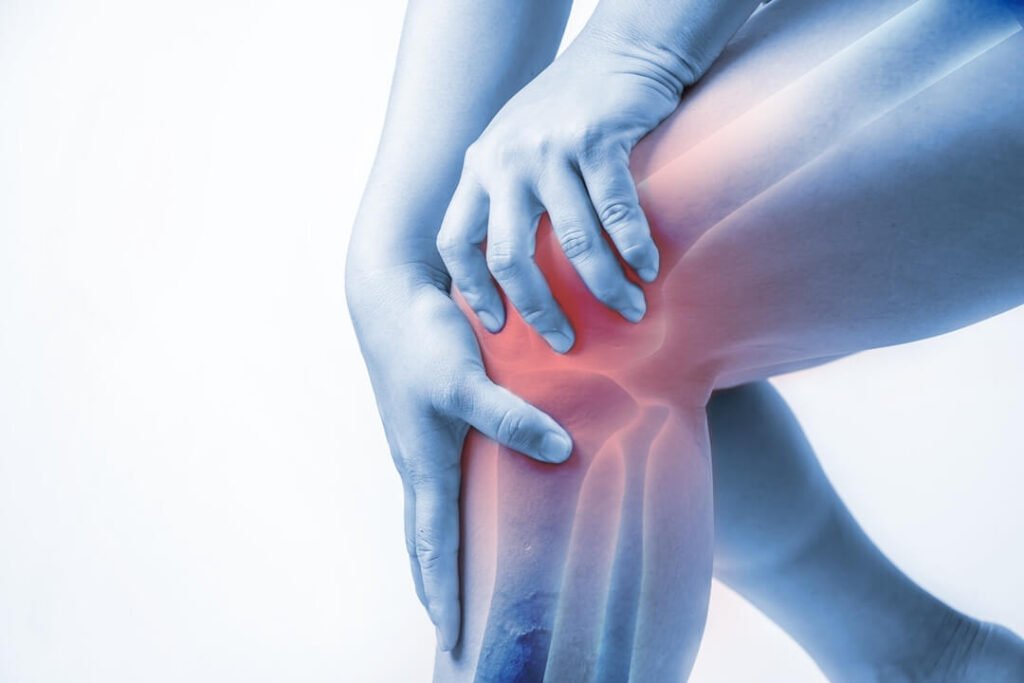
Recovery from surgery, whether it’s an operation for joint replacement, ACL repair, or other orthopaedic procedures, may be daunting. Although the procedure can fix the problem, the body needs to be guided in order to recover strength and mobility; this is where physiotherapy can make a huge difference. It can help patients heal faster, get better more efficiently, and prevent the possibility of future issues. Why Physiotherapy Matters After Surgery Surgery is only the beginning process. If you don’t get the proper treatment, it is possible to suffer discomfort, stiffness and delay in recovery. Physical therapy can assist you in: In brief, physiotherapy fills in the gap between surgical procedures and returning to normal activities. Recovering From Joint Replacement The hip or knee replacement usually results in stiff joints as well as weak muscles. A physiotherapist develops a custom program to assist you in: Physiotherapy After ACL Surgery An ACL reconstruction requires careful rehabilitation in order to safeguard the new ligament. Key Rehab Techniques The physiotherapist uses a variety of techniques to accelerate recovery: Long-Term Advantages It’s not just about quick recuperation. It can also help improve the posture of patients, help improve their motion patterns and also help avoid future pain or injury flare-ups. Expert Help in Gurgaon If you want to get the best results, having a qualified professional physiotherapist in Gurgaon will help you recover faster and with less risk. A qualified therapist will create an appropriate plan for the type of surgery you have, your lifestyle, and age, which will allow you to return to your normal routine at ease and in comfort. FAQs What is the best time to begin exercise following the surgery?Most patients begin their therapy within 24 hours. However, always abide by the advice of your doctor. Are the exercises uncomfortable?You may experience some discomfort; nevertheless, exercises are created to be comfortable and safe. What is the time it will take to heal after the joint replacement procedure?It typically takes about 3 to 6 months, based on your body as well as the procedure. Do physiotherapy sessions decrease my use of medication for pain?Yes. The regular sessions can help ease swelling and pain, usually decreasing the need for medications. Do I need therapy if I’m feeling okay?Absolutely. Therapy ensures complete healing that restores strength and helps prevent future issues.
Frozen Shoulder: Signs, Symptoms & Physical Therapy Treatment Options in Gurgaon

What Is Frozen Shoulder? A frozen shoulder, commonly known as adhesive capsulitis, can be painful and cause pain as the shoulder joint is stiff and unable to move. It usually begins slowly but gets worse over time, making routine activities such as getting your hair brushed and dressing or sleeping on the side that is affected painful. This type of condition occurs most commonly in people between the ages of 40 and 60 years old. It can be triggered by injury, surgical procedures, or certain diseases such as diabetes. Common Signs and Symptoms Being aware of the warning signs for frozen shoulder can help you receive prompt treatment as well as avoid issues. Why It Happens The cause of the problem isn’t always evident; however, the most common cause is that the capsule in the shoulder joints thickens and contracts. Risk factors include: How Physical Therapy Helps Physiotherapy is by far the best treatment for frozen shoulders without surgery. A professional physiotherapist will develop an individualised plan that is based on your specific symptoms and the level of healing. Gentle Stretching Gentle, controlled stretching exercises help reduce stiffness and increase flexibility with time. Manual Therapy The hands-on methods of mobilisation of joints, as well as massage for soft tissue, help to ease the pain and help increase mobility. Heat and Cold Applications The heat relaxes shoulder muscles prior to exercise. Ice packs help reduce the inflammation that occurs after exercise. Strengthening Exercises When movement is improved, enlarging the muscles around it helps stabilise the shoulder and avoids any future injuries. Other Treatment Options Sometimes, doctors might suggest pain relievers or corticosteroid injections. However, generally, they’re coupled with physical therapy to achieve the most effective results. Expert Care in Gurgaon If you’re suffering from frozen shoulder, do not wait for it to heal by itself. The sooner you treat it, the faster the recovery process and the discomfort you will experience. A consultation with skilled physiotherapist at physiotherapist in Gurgaon will help you recover your mobility and get back to daily activities sooner and with more ease. FAQs What is the time frame for frozen shoulder healing? Recovery can take between 6 months and two years, based on the type of treatment used and its consistency. Does it heal with or without therapy?It could, however, physical therapy speedens the recovery process and reduces the risk of stiffness for long periods. Do you think frozen shoulder is identical to arthritis?No, the shoulder capsule and not the joint cartilage, is the cause of arthritis. Do exercises cause it to become more difficult?When performed correctly and under the physical therapist’s guidance, exercises can be secure and helpful. Who’s at the highest risk?People suffering from thyroid or diabetes, as well as those who are recovering from surgeries or injuries to the shoulder, are more at risk.
